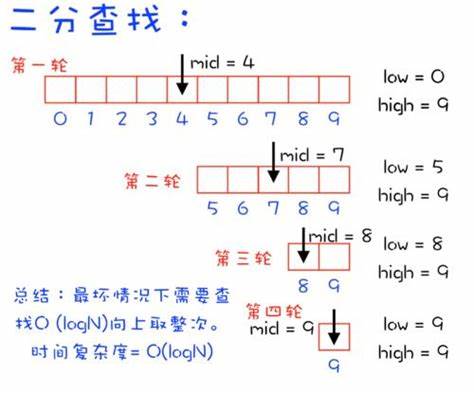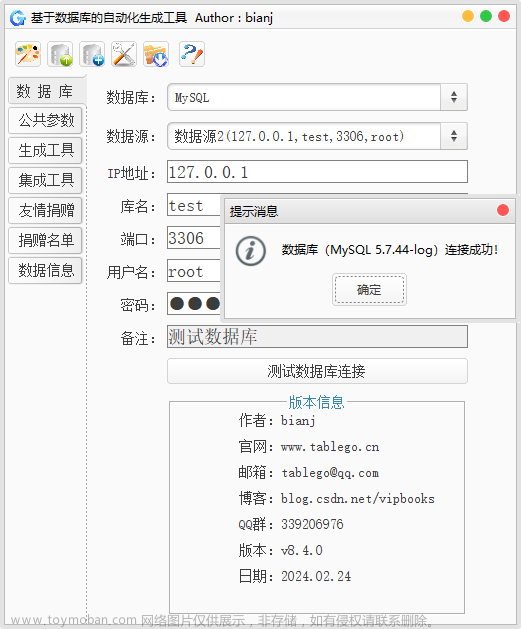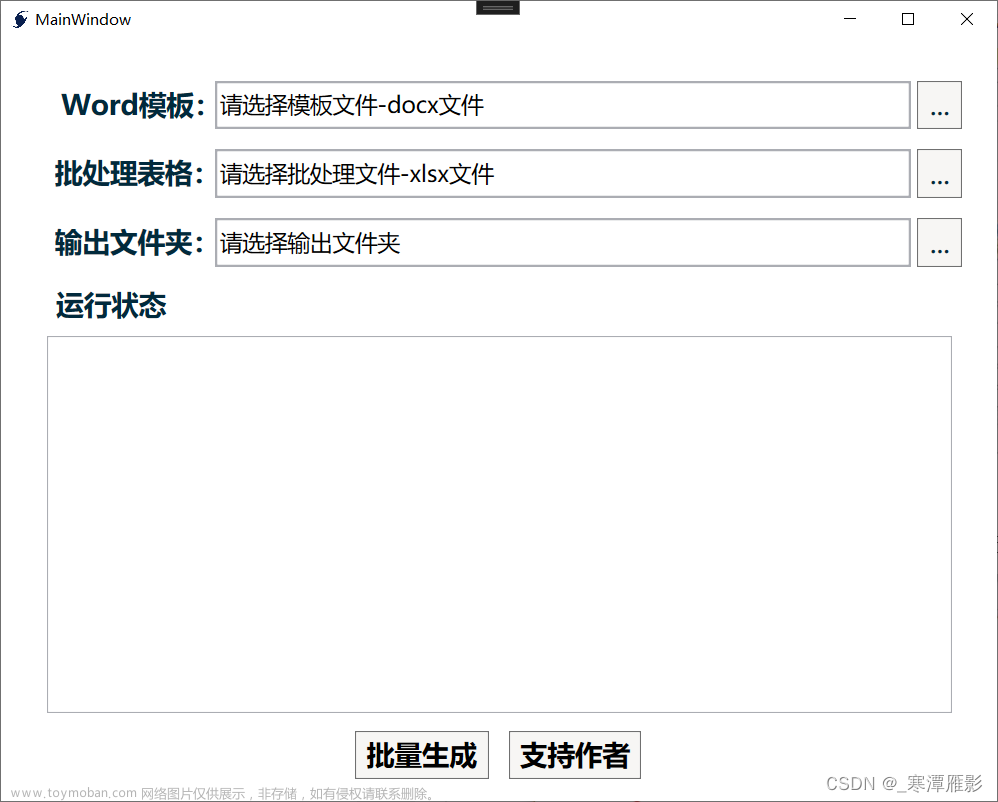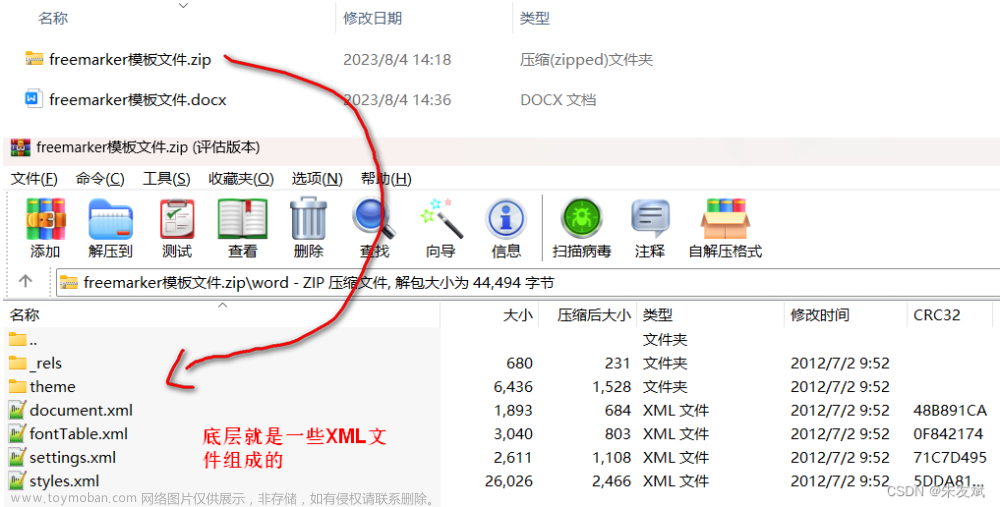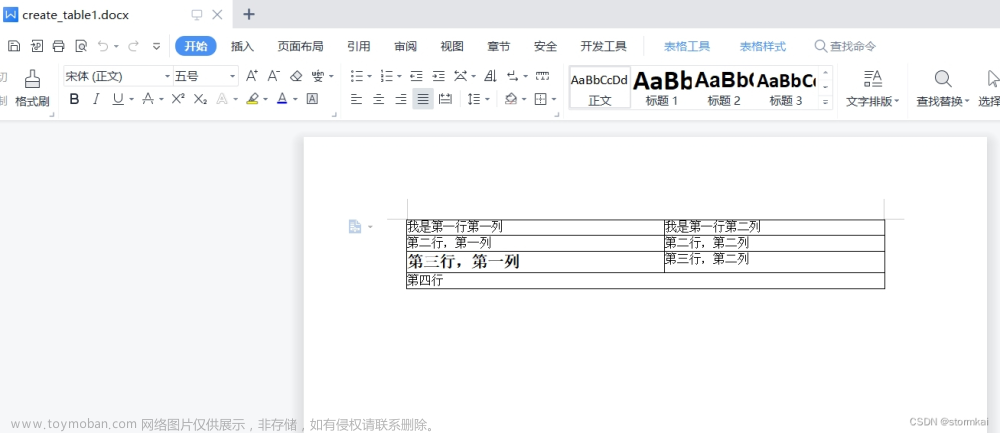生成Word文档是通过使用PHP中的库或扩展来操作。在PHP中,有许多第三方库和扩展可用于生成Word文档,下面将介绍使用php生成word文档的多种方法总有一种适合你。
1、使用 PHPWord库生成word文档
最常用的是PHPWord库。
PHPWord - 用于读写文字处理文档(OOXML、ODF、RTF、HTML、PDF)的纯 PHP 库
下面是使用PHPWord库生成Word文档的基本步骤:
1、使用 composer 安装PHPWord库,也可以这几上去github下载,这里就不多说了。
composer require phpoffice/phpword
2、在你的PHP脚本中,引入PHPWord库的自动加载器:
require_once 'vendor/autoload.php';
3、创建一个新的Word文档对象:
$phpWord = new \PhpOffice\PhpWord\PhpWord();
4、添加文本到文档:
$section = $phpWord->addSection();
$section->addText('你的文本内容');5、保存文档为Word文件:
$phpWord->save('path/to/save.docx');以上是一个简单的示例,你可以根据自己的需求进一步探索PHPWord库的其他功能和选项,例如添加样式、表格、图片等。
总结一下,通过使用PHPWord库,你可以轻松地在PHP中生成Word文档。记得在开始之前安装PHPWord库,并按照上述步骤编写你的PHP代码。这样,你就可以根据自己的需求生成自定义的Word文档了。
完整的PHPWord 库的基本使用示例
require_once 'bootstrap.php';
// 创建新文档...
$phpWord = new \PhpOffice\PhpWord\PhpWord();
/* 注意:附加到文档的任何元素都必须位于节内. */
// 添加一个空的Section到文档...
$section = $phpWord->addSection();
// 将 Text 元素添加到默认字体样式的部分...
$section->addText(
'"从昨天学习,为今天生活,为明天祈祷。 '
. '重要的是不要停止质疑。" '
. '(文章内容)'
);
/*
* 注意:可以通过三种方式自定义添加的文本元素的字体样式:
* - 内联;
* - 使用命名字体样式(将隐式创建新的字体样式对象);
* - 使用显式创建的字体样式对象。
*/
// 添加带有自定义字体的内联文本元素...
$section->addText(
'"伟大的成就通常源于巨大的牺牲, '
. '并且绝不是自私的结果。" '
. '(文章内容)',
array('name' => 'Tahoma', 'size' => 10)
);
// 添加使用命名字体样式自定义字体的文本元素...
$fontStyleName = 'oneUserDefinedStyle';
$phpWord->addFontStyle(
$fontStyleName,
array('name' => 'Tahoma', 'size' => 10, 'color' => '1B2232', 'bold' => true)
);
$section->addText(
'"最大的成就不是永不跌倒,'
. '而是在跌倒后再次站起来。" '
. '(文章内容)',
$fontStyleName
);
// 添加使用显式创建的字体样式对象自定义字体的文本元素...
$fontStyle = new \PhpOffice\PhpWord\Style\Font();
$fontStyle->setBold(true);
$fontStyle->setName('Tahoma');
$fontStyle->setSize(13);
$myTextElement = $section->addText('"相信你可以,你就已经成功了一半。" (文章内容)');
$myTextElement->setFontStyle($fontStyle);
// 将文档保存为 OOXML 文件...
$objWriter = \PhpOffice\PhpWord\IOFactory::createWriter($phpWord, 'Word2007');
$objWriter->save('helloWorld.docx');
// 将文档保存为 ODF 文件...
$objWriter = \PhpOffice\PhpWord\IOFactory::createWriter($phpWord, 'ODText');
$objWriter->save('helloWorld.odt');
// 将文档保存为 HTML 文件...
$objWriter = \PhpOffice\PhpWord\IOFactory::createWriter($phpWord, 'HTML');
$objWriter->save('helloWorld.html');
/* 注意:我们跳过 RTF,因为它不是基于 XML 的并且需要不同的示例。*/
/* 注意:我们跳过 PDF,因为使用“HTML-to-PDF”方法来创建 PDF 文档。*/
// 更多示例,可以查看 PHPWORD 官方文档2、利用windows下面的 com组件
使用windows下的com组件,com作为PHP的一个扩展类,安装过office的服务器会自动调用word.application的com,可以自动生成文档,PHP官方文档手册查看具体说明(https://www.php.net/manual/en/class.com.php)
示例代码如下
<?php
// starting word
$word = new COM("word.application") or die("Unable to instantiate Word");
echo "Loaded Word, version {$word->Version}\n";
//bring it to front
$word->Visible = 1;
//open an empty document
$word->Documents->Add();
//do some weird stuff
$word->Selection->TypeText("This is a test...");
$word->Documents[1]->SaveAs("Useless test.doc");
//closing word
$word->Quit();
//free the object
$word = null;
?>个人建议:com实例后的方法都需要查找官方文档才知道什么意思,个人觉得不是太方便,另外这个效率也不是很高,不推荐使用。
3、使用 php html网页导出Word文档
说明原理
一般情况下,有两种方法可以导出doc文档。
一种方法是使用com,并将其作为PHP的一个扩展库安装到服务器上。然后,创建一个com对象并调用其方法。安装了Office套件的服务器可以调用一个名为"word.application"的com对象,利用它可以生成Word文档。但是,我不推荐这种方法,因为执行效率比较低(我进行了一些测试,发现在执行代码时,服务器会真实地打开一个Word客户端)。理想情况下,com对象应该是无界面的,在后台进行数据转换,这样效果会更好。但是,这些扩展一般都需要付费。
第二种方法则是直接用PHP将我们的文档内容写入一个后缀为.doc的文件中。这种方法不依赖于第三方扩展,并且执行效率较高。
Word本身具备很强大的功能,它可以打开HTML格式的文件,并且能够保留格式,即使后缀名为.doc,它也能正常识别。这为我们提供了方便。然而,在HTML格式的文件中,图片只是链接,而真正的图片文件是保存在其他地方的。也就是说,如果将HTML格式直接写入.doc文件中,其中就不会包含图片。那么,我们如何创建带有图片的Word文档呢?我们可以使用与HTML相似的MHT格式。
MHT格式与HTML非常相似,唯一的区别在于MHT格式中,外部链接引入的文件(如图片、JavaScript、CSS)会被Base64编码存储。因此,单个MHT文件就能保存网页中的所有资源。当然,相比HTML,MHT文件的尺寸会更大。
Word能否识别MHT格式呢?我将一个网页保存为MHT格式,然后将后缀名修改为.doc,并用Word打开,结果是OK,Word也能正常识别MHT文件并显示其中的图片。
好了,既然Word可以识别MHT格式,接下来我们就考虑如何将图片插入到MHT中。由于HTML代码中的图片路径保存在img标签的src属性中,只需要提取HTML代码中的src属性值,就能获取到图片的地址。即使是相对路径,也可以加上URL的前缀,转换为绝对路径。一旦有了图片地址,我们就可以使用file_get_content函数获取到图片文件的实际内容,然后调用base64_encode函数将文件内容编码为Base64编码,最后将其插入到MHT文件的适当位置即可。
最后,我们有两种方法将文件发送给客户端。一种方法是先在服务器端生成一个.doc文档,并记录下这个文档的地址;最后,通过header("location:xx.doc")将文档地址发送给客户端,让客户端下载该文档。另一种方法是直接发送HTML请求,修改HTML协议头部,将content-type设置为application/doc,并将content-disposition设置为attachment,后面跟上文件名。在发送完HTML协议以后,直接将文件内容发送给客户端,也可以让客户端下载该.doc文件。
完整示例封装函数代码
/**
* 根据HTML代码获取word文档内容
* 创建一个本质为mht的文档,该函数会分析文件内容并从远程下载页面中的图片资源
* 该函数依赖于类MhtFileMaker
* 该函数会分析img标签,提取src的属性值。但是,src的属性值必须被引号包围,否则不能提取
*
* @param string $content HTML内容
* @param string $absolutePath 网页的绝对路径。如果HTML内容里的图片路径为相对路径,那么就需要填写这个参数,来让该函数自动填补成绝对路径。这个参数最后需要以/结束
* @param bool $isEraseLink 是否去掉HTML内容中的链接
*/
function getWordDocument( $content , $absolutePath = "" , $isEraseLink = true )
{
$mht = new MhtFileMaker();
if ($isEraseLink)
$content = preg_replace('/<a\s*.*?\s*>(\s*.*?\s*)<\/a>/i' , '$1' , $content); //去掉链接
$images = array();
$files = array();
$matches = array();
//这个算法要求src后的属性值必须使用引号括起来
if ( preg_match_all('/<img[.\n]*?src\s*?=\s*?[\"\'](.*?)[\"\'](.*?)\/>/i',$content ,$matches ) )
{
$arrPath = $matches[1];
for ( $i=0;$i<count($arrPath);$i++)
{
$path = $arrPath[$i];
$imgPath = trim( $path );
if ( $imgPath != "" )
{
$files[] = $imgPath;
if( substr($imgPath,0,7) == 'http://')
{
//绝对链接,不加前缀
}
else
{
$imgPath = $absolutePath.$imgPath;
}
$images[] = $imgPath;
}
}
}
$mht->AddContents("tmp.html",$mht->GetMimeType("tmp.html"),$content);
for ( $i=0;$i<count($images);$i++)
{
$image = $images[$i];
if ( @fopen($image , 'r') )
{
$imgcontent = @file_get_contents( $image );
if ( $content )
$mht->AddContents($files[$i],$mht->GetMimeType($image),$imgcontent);
}
else
{
echo "file:".$image." not exist!<br />";
}
}
return $mht->GetFile();
}使用方法:
$fileContent = getWordDocument($content,"http://www.yoursite.com/Music/etc/");
$fp = fopen("test.doc", 'w');
fwrite($fp, $fileContent);
fclose($fp);其中,$content变量应该是HTML源代码,后面的链接应该是能填补HTML代码中图片相对路径的URL地址
注意,在使用这个函数之前,您需要先包含类MhtFileMaker,这个类可以帮助我们生成Mht文档。
MhtFileMaker类
<?php
class MhtFileMaker{
var $config = array();
var $headers = array();
var $headers_exists = array();
var $files = array();
var $boundary;
var $dir_base;
var $page_first;
function MhtFile($config = array()){
}
function SetHeader($header){
$this->headers[] = $header;
$key = strtolower(substr($header, 0, strpos($header, ':')));
$this->headers_exists[$key] = TRUE;
}
function SetFrom($from){
$this->SetHeader("From: $from");
}
function SetSubject($subject){
$this->SetHeader("Subject: $subject");
}
function SetDate($date = NULL, $istimestamp = FALSE){
if ($date == NULL) {
$date = time();
}
if ($istimestamp == TRUE) {
$date = date('D, d M Y H:i:s O', $date);
}
$this->SetHeader("Date: $date");
}
function SetBoundary($boundary = NULL){
if ($boundary == NULL) {
$this->boundary = '--' . strtoupper(md5(mt_rand())) . '_MULTIPART_MIXED';
} else {
$this->boundary = $boundary;
}
}
function SetBaseDir($dir){
$this->dir_base = str_replace("\\", "/", realpath($dir));
}
function SetFirstPage($filename){
$this->page_first = str_replace("\\", "/", realpath("{$this->dir_base}/$filename"));
}
function AutoAddFiles(){
if (!isset($this->page_first)) {
exit ('Not set the first page.');
}
$filepath = str_replace($this->dir_base, '', $this->page_first);
$filepath = 'http://mhtfile' . $filepath;
$this->AddFile($this->page_first, $filepath, NULL);
$this->AddDir($this->dir_base);
}
function AddDir($dir){
$handle_dir = opendir($dir);
while ($filename = readdir($handle_dir)) {
if (($filename!='.') && ($filename!='..') && ("$dir/$filename"!=$this->page_first)) {
if (is_dir("$dir/$filename")) {
$this->AddDir("$dir/$filename");
} elseif (is_file("$dir/$filename")) {
$filepath = str_replace($this->dir_base, '', "$dir/$filename");
$filepath = 'http://mhtfile' . $filepath;
$this->AddFile("$dir/$filename", $filepath, NULL);
}
}
}
closedir($handle_dir);
}
function AddFile($filename, $filepath = NULL, $encoding = NULL){
if ($filepath == NULL) {
$filepath = $filename;
}
$mimetype = $this->GetMimeType($filename);
$filecont = file_get_contents($filename);
$this->AddContents($filepath, $mimetype, $filecont, $encoding);
}
function AddContents($filepath, $mimetype, $filecont, $encoding = NULL){
if ($encoding == NULL) {
$filecont = chunk_split(base64_encode($filecont), 76);
$encoding = 'base64';
}
$this->files[] = array('filepath' => $filepath,
'mimetype' => $mimetype,
'filecont' => $filecont,
'encoding' => $encoding);
}
function CheckHeaders(){
if (!array_key_exists('date', $this->headers_exists)) {
$this->SetDate(NULL, TRUE);
}
if ($this->boundary == NULL) {
$this->SetBoundary();
}
}
function CheckFiles(){
if (count($this->files) == 0) {
return FALSE;
} else {
return TRUE;
}
}
function GetFile(){
$this->CheckHeaders();
if (!$this->CheckFiles()) {
exit ('No file was added.');
}
$contents = implode("\r\n", $this->headers);
$contents .= "\r\n";
$contents .= "MIME-Version: 1.0\r\n";
$contents .= "Content-Type: multipart/related;\r\n";
$contents .= "\tboundary=\"{$this->boundary}\";\r\n";
$contents .= "\ttype=\"" . $this->files[0]['mimetype'] . "\"\r\n";
$contents .= "X-MimeOLE: Produced By Mht File Maker v1.0 beta\r\n";
$contents .= "\r\n";
$contents .= "This is a multi-part message in MIME format.\r\n";
$contents .= "\r\n";
foreach ($this->files as $file) {
$contents .= "--{$this->boundary}\r\n";
$contents .= "Content-Type: $file[mimetype]\r\n";
$contents .= "Content-Transfer-Encoding: $file[encoding]\r\n";
$contents .= "Content-Location: $file[filepath]\r\n";
$contents .= "\r\n";
$contents .= $file['filecont'];
$contents .= "\r\n";
}
$contents .= "--{$this->boundary}--\r\n";
return $contents;
}
function MakeFile($filename){
$contents = $this->GetFile();
$fp = fopen($filename, 'w');
fwrite($fp, $contents);
fclose($fp);
}
function GetMimeType($filename){
$pathinfo = pathinfo($filename);
switch ($pathinfo['extension']) {
case 'htm': $mimetype = 'text/html'; break;
case 'html': $mimetype = 'text/html'; break;
case 'txt': $mimetype = 'text/plain'; break;
case 'cgi': $mimetype = 'text/plain'; break;
case 'php': $mimetype = 'text/plain'; break;
case 'css': $mimetype = 'text/css'; break;
case 'jpg': $mimetype = 'image/jpeg'; break;
case 'jpeg': $mimetype = 'image/jpeg'; break;
case 'jpe': $mimetype = 'image/jpeg'; break;
case 'gif': $mimetype = 'image/gif'; break;
case 'png': $mimetype = 'image/png'; break;
default: $mimetype = 'application/octet-stream'; break;
}
return $mimetype;
}
}
?>4、使用纯html格式导出WORD
利用ob_start把html页面先存储起来(解决一下页面多个header问题,可以批量生成),然后在写入doc文档内容利用文章来源:https://www.toymoban.com/diary/php/432.html
示例代码
<?php
class word
{
function start()
{
ob_start();
echo '<html xmlns:o="urn:schemas-microsoft-com:office:office"
xmlns:w="urn:schemas-microsoft-com:office:word"
xmlns="http://www.w3.org/TR/REC-html40">';
}
function save($path)
{
echo "</html>";
$data = ob_get_contents();
ob_end_clean();
$this->wirtefile ($path,$data);
}
function wirtefile ($fn,$data)
{
$fp=fopen($fn,"wb");
fwrite($fp,$data);
fclose($fp);
}
}
$html = '<table width=600 cellpadding="6" cellspacing="1" bgcolor="#336699">
<tr bgcolor="White">
<td>Toy模板网</td>
<td>这是文章内容...这是文章内容...这是文章内容</td>
</tr>
<tr bgcolor="red">
<td>Toy模板网</td>
<td>这是文章内容...这是文章内容...这是文章内容</td>
</tr>
<tr bgcolor="White">
<td colspan=2 >
Toy模板网<br>
最靠谱的PHP技术博客分享网站
<img src="https://www.toymoban.com/style/defalut/img/logo.png">
</td>
</tr>
</table>
';
//批量生成
for($i=1;$i<=3;$i++){
$word = new word();
$word->start();
//$html = "aaa".$i;
$wordname = 'Toy模板网'.$i.".doc";
echo $html;
$word->save($wordname);
ob_flush();//每次执行前刷新缓存
flush();
}
文章来源地址https://www.toymoban.com/diary/php/432.html
到此这篇关于如何使用php生成word文档的文章就介绍到这了,更多相关内容可以在右上角搜索或继续浏览下面的相关文章,希望大家以后多多支持TOY模板网!


